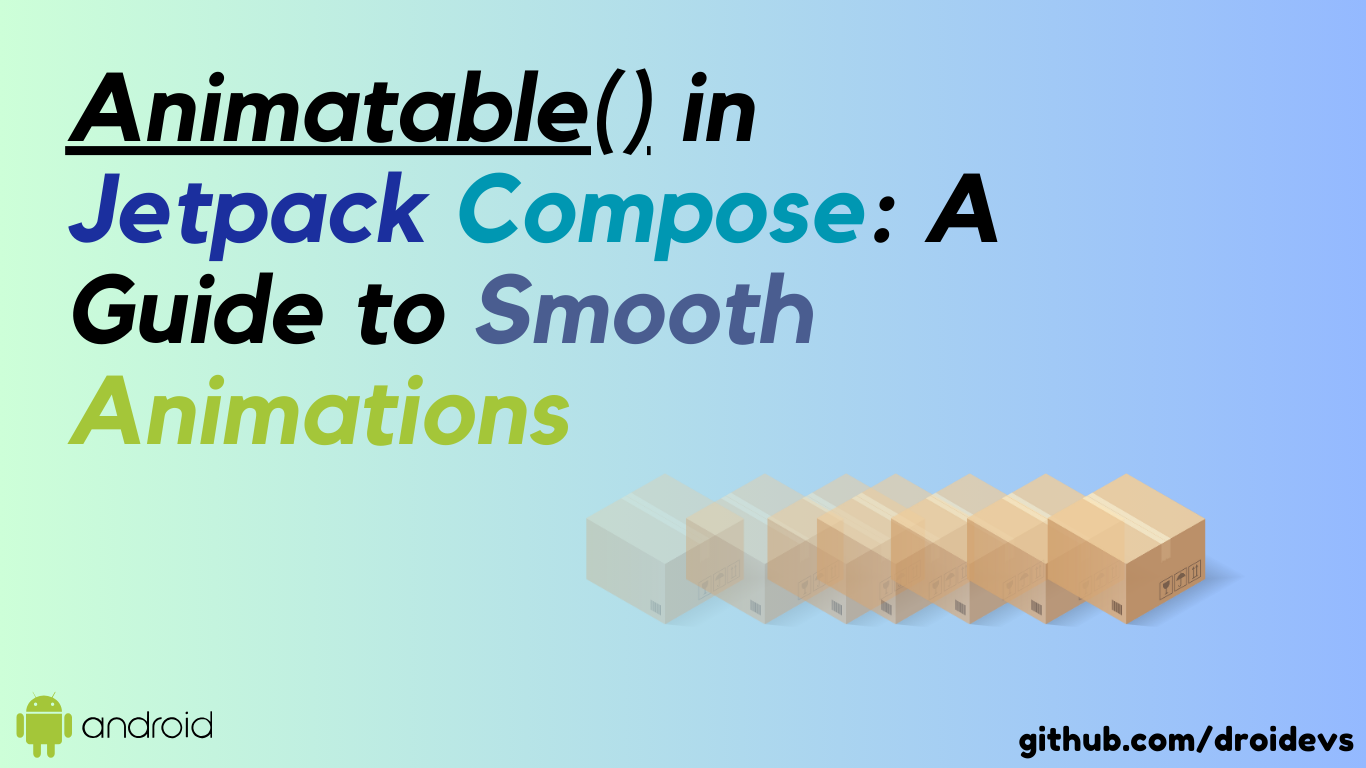Animatable() in Jetpack Compose: A Guide to Smooth Animations
 Mouad Oumous
Mouad Oumous
Jetpack Compose provides powerful animation APIs to create smooth and visually appealing UI effects. One such API is Animatable(), which allows you to animate values over time while giving you fine-grained control over their behavior.
In this article, we'll explore what Animatable() is, how it works, and how to use it effectively in your Jetpack Compose applications.
What is Animatable()?
Animatable() is a state-driven animation API in Jetpack Compose that helps you animate values such as floats, colors, and other numeric types. Unlike simple animate*AsState() functions, Animatable() allows more control over animations, such as pausing, resuming, stopping, or chaining animations.
Key Features:
Supports multiple data types (
Float,Color,Dp, etc.)Allows suspending functions for finer control (pause, resume, stop)
Provides precise control over animation duration, easing, and velocity
Enables sequential or parallel animations with coroutines
How to Use Animatable() in Jetpack Compose
To use Animatable(), follow these steps:
Create an
Animatableinstance with an initial value.Use the
animateTo()function to animate the value.Modify properties such as duration, easing, and velocity.
Use coroutines to trigger and control animations.
Example 1: Basic Animation with Animatable()
Here's a simple example where we animate a circle's movement across the screen when a button is clicked:
@Composable
fun AnimatableExample() {
val position = remember { Animatable(0f) }
val scope = rememberCoroutineScope()
Column(
modifier = Modifier.fillMaxSize(),
verticalArrangement = Arrangement.Center,
horizontalAlignment = Alignment.CenterHorizontally
) {
Box(
modifier = Modifier
.size(100.dp)
.offset(x = position.value.dp)
.background(Color.Blue, shape = CircleShape)
)
Spacer(modifier = Modifier.height(20.dp))
Button(onClick = {
scope.launch {
position.animateTo(
targetValue = 300f,
animationSpec = tween(durationMillis = 1000, easing = LinearOutSlowInEasing)
)
}
}) {
Text("Move")
}
}
}
Explanation:
We create an
Animatable(0f)instance to track the position.A coroutine is launched when the button is clicked to animate the value from
0fto300f.We use
tween()for smooth animation with easing.
Example 2: Animating Color with Animatable()
Animatable() is not limited to floats; it can also animate colors. Below is an example of changing the color of a box when clicked:
@Composable
fun ColorAnimationExample() {
val color = remember { Animatable(Color.Red) }
val scope = rememberCoroutineScope()
Box(
modifier = Modifier
.size(200.dp)
.background(color.value)
.clickable {
scope.launch {
color.animateTo(Color.Green, animationSpec = tween(1000))
}
}
)
}
Explanation:
The box starts with
Color.Red.When clicked, it animates to
Color.Greenover 1 second usingtween().
Example 3: Chaining Animations Sequentially
You can chain animations using coroutines to create more complex sequences:
@Composable
fun SequentialAnimationExample() {
val size = remember { Animatable(100f) }
val scope = rememberCoroutineScope()
Box(
modifier = Modifier
.size(size.value.dp)
.background(Color.Magenta)
.clickable {
scope.launch {
size.animateTo(200f, animationSpec = tween(500))
size.animateTo(100f, animationSpec = tween(500))
}
}
)
}
Explanation:
The box grows to
200.dpand then shrinks back to100.dp.The animations run sequentially using coroutines.
Example 4: Spring Animation
To make an animation more natural, you can use spring() instead of tween():
scope.launch {
position.animateTo(
targetValue = 300f,
animationSpec = spring(
dampingRatio = Spring.DampingRatioMediumBouncy,
stiffness = Spring.StiffnessLow
)
)
}
Explanation:
spring()makes the animation more dynamic, adding a bounce effect.
When to Use Animatable()?
When you need precise control over animation (pause, resume, stop)
When animating values other than simple floats (like
ColororDp)When chaining animations or running them in sequence
When you want more control than
animate*AsState()provides
Conclusion
Animatable() in Jetpack Compose is a powerful tool for creating smooth and controlled animations. Whether you're animating movement, color, or chaining multiple animations, Animatable() offers the flexibility you need to enhance your UI interactions.
By using coroutines and different animation specs (tween(), spring()), you can create engaging and dynamic animations effortlessly. Experiment with these examples to bring your Jetpack Compose UI to life!
Subscribe to my newsletter
Read articles from Mouad Oumous directly inside your inbox. Subscribe to the newsletter, and don't miss out.
Written by
